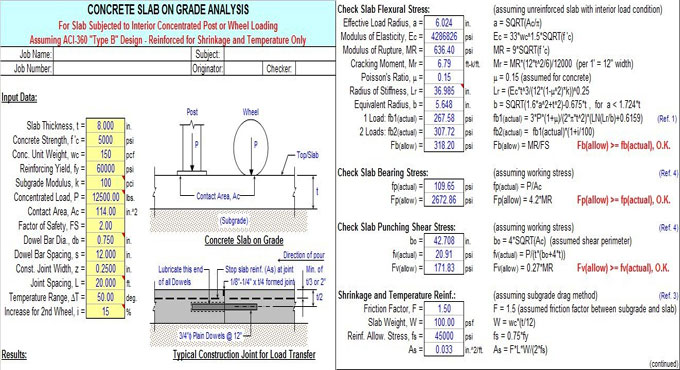
Make analysis of Concrete Slabs On Grade With GRDSLAB
Alex Tomanovich has developed GRDSLAB. It is a spreadsheet based program powered by MS-Excel that can be used for evaluating the concrete slabs on grade. Particularly, a concrete slab on grade is dependent on concentrated post or wheel loading. This construction program facilitates to examine the slab flexural, bearing, and shear stresses; compute the crack width; define the minimum required distribution reinforcing as well as examine the bearing stress on the dowels at construction joints for the specified parameters.
Besides, design charts from the Portland Cement Association (PCA) are integrated to give a supplementary method for defining or examining the necessary slab thickness for flexure. Evaluating the capacity of a slab on grade is dependent on continuous wall (line-type) load and stationary, uniformly distributed live loads are also arranged.
This program is based on the following theorem:-
1. The "Slab on Grade" worksheet supposes a structurally unreinforced slab, ACI-360"Type B", reinforced only for shrinkage and temperature. An interior load condition is assumed for flexural analysis. It means, the concentrated post or wheel load is accepted to be well far from a "free" slab edge or corner. The original theory and equations by H.M. Westergaard (1926) as rectified by Reference (a) in item #1 above are applied forthe flexual stress analysis. Some of the more crucial and refining assumptions provided in the Westergaard analysis model are given below:
Sand Lime Brick:
? Slab functions as a homogenous, isotropic elastic solid in equilibrium, devoid of any discontinuities.
? Slab contains consistent density, and the neutral axis is arranged at mid-depth.
? All forces function normal to the surface (shear and friction forces are accepted as insignificant).
? Deformation inside the elements, normal to slab surface, are taken into consideration.
? Shear deformation is insignificant.
? Slab is taken as infinite for center loading and semi-infinite for edge loading.
? Load at interior and corner of slab circulated equally of a circular contact area.
? Full contact (support) among the slab and foundation.
3. Other basic assumptions applied in the flexural analysis of the "Slab on Grade" worksheet are described below:
? Slab observed as a plate on a liquid foundation with full subgrade contact (subgrade modeled as a series of independent springs - also defined as "Winkler" foundation.)
? Modulus of subgrade reaction ("k") is applied to demonstrate the subgrade.
? Slab is treated as unreinforced concrete beam, in order that any contribution made to flexural strength with the addition of distribution reinforcement is ignored.
? Amalgamation of flexural and direct tensile stresses will lead to transverse and longitudinal cracks.
? Supporting subbase and/or subgrade function as elastic material, recapturing position as soon as load is applied.
To get more information, click on the following link www.cesdb.com


